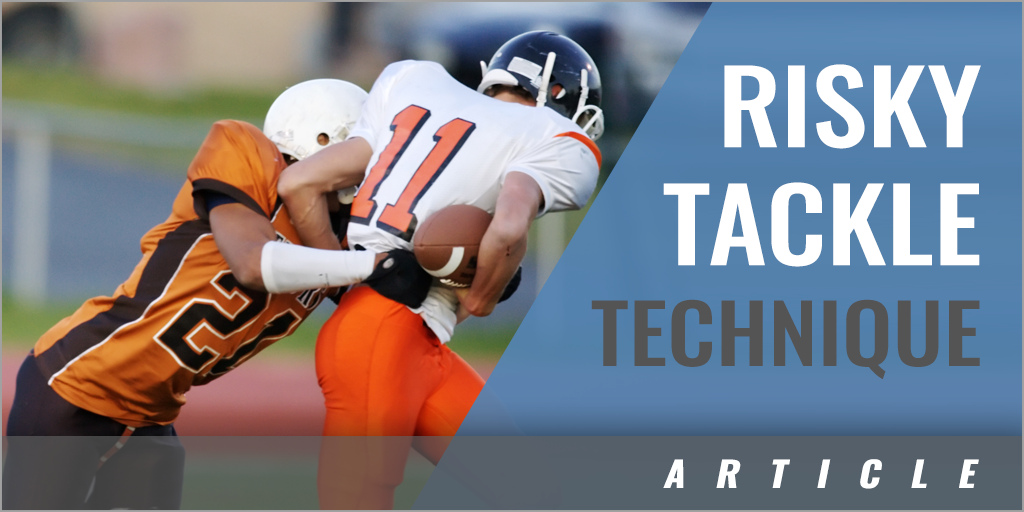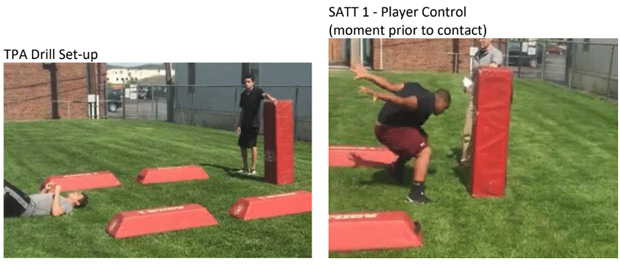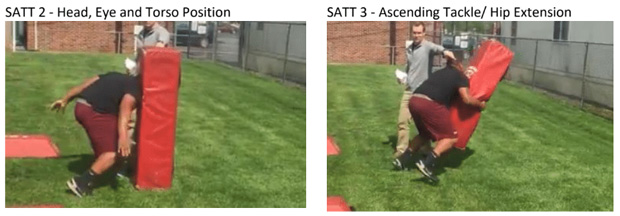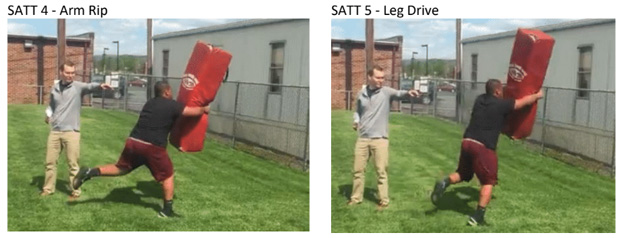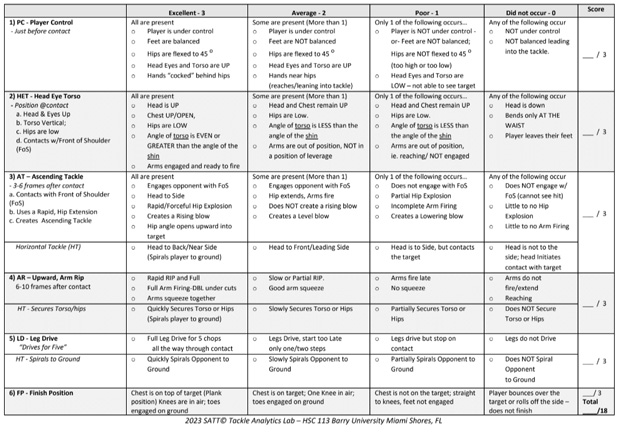|
By: Scott R Dietrich - Barry Univ., Nasik Muhammad Nafi - Kansas State Univ., Tim Hibbs & Reggie Givens - Pine Crest School (FL) USA Football® and the CDC have made advancements on how coaches are trained to teach tackle skills, yet it remains unknown if youth and high school football players can effectively adopt and utilize these skills (Kerr et al., 2017). A coach's ability to assess key tackle components is an important part of teaching fundamentals and for early identification of risky tackle performance. Categorizing tackle performance as either safe or risky at key points during skill performance coupled with providing meaningful, corrective feedback can help evaluate overall tackle quality and possibly reduce the risk of sustaining serious head or neck injuries. The purpose of this article is to introduce a video-based screening intervention: Standard Assessment of Tackle Technique (SATT) and provide corrective strategies for measuring the quality of tackle performance. Learning objectives for this article are to: 1) describe the correct set up for recording the Tackle Proficiency Assessment (TPA) drill, 2) identify six key components for assessing a Level 1 (shoulders to hips), frontside football tackle, and 3) provide cues for correcting technique faults common in a risky tackle. The target audience for this article is coaches, however officials and medical professionals who supervise youth and scholastic football may benefit as well. Standard Assessment of Tackle Technique (SATT) is a field-based, assessment tool designed screen players for early identification of unsafe tackle skill performance. To determine interrater reliability, 2 raters independently scored video recordings of twelve players performing the Tackling Proficiency Assessment (TPA) drill Appendix B on three separate testing sessions spaced at least a week apart. Raters were considered experts by having a minimum of 5 years' football playing experience and completed a thirty-minute training session that included scoring a selection of recorded samples as well as a thorough review of all scoring components. Rater, one had experience playing football at the secondary school level and was a licensed athletic trainer with more than ten years' experience. The second rater had 13 years playing experience in youth, secondary and collegiate level, as well as 20 years' experience as a licensed athletic trainer and an earned doctorate in physical education teacher education. Tackle Proficiency Assessment Drill To adequately evaluate the critical components of a proper tackle form, an easily reproducible, sport-specific task that closely mirrors the physical demands of a tackle was used. The Tackle Proficiency Assessment (TPA) was adapted from a 1 vs 1, Oklahoma-style, tackling drill and it was selected because it can be scaled to include more advanced game-like conditions by coupling it with additional movements like low agility rolls or tackling a moving target. The drill must always be completed with a tackle dummy and not a live opponent, for reproducible results and to prioritize player safety. The TPA drill starts with the athlete lying on their back with their head five yards away from an 18lb Rugged Square™ standup blocking dummy. The blocking dummy is placed in the middle of four Agile 2™ field training bags, and a camera is placed 90 degrees to the right-side of the blocking dummy. On a "Hit" command the athlete gets up from a lying position and spins to face the target and completes a tackle using the stationary bag to simulate the ball carrier. Following the recording session each video is analyzed using playback on a desktop computer. Standard Assessment of Tackling Technique (SATT) - Appendix B. The Standard Assessment of Tackling Technique (SATT) is a scoring rubric used to measure the presence and quality of performance for 5 fundamental elements of an American football tackle. Each element is scored using a 4-point ordinal scale (0-3) that evaluates overall tackle quality based on a total score (i.e., max score of 15 points), and tackle safety by monitoring head and torso position at the point of contact. The five elements of a proper form tackle are: Player Control (PC); Head Eye and Torso position (HET); creates an ascending tackle (AT) using a rapid hip extension; upward, Arm Rip (AR); and sustains a Leg Drive (LD). A score of zero (0) is assigned if the component does not occur. A score of one (1) is earned if the component was present but performed in an inefficient or ineffective manner. A score of two (2) is earned if the component occurs with only some of the criteria for movement fluency. A score of three (3) is earned if all criteria for movement fluency are met for that element. Appendix B. Common Performance Faults Through the course of this investigation several common themes developed by watching and scoring more than 800 video samples of the TPA drill. A fault is considered a breakdown in skill performance that prohibits one or more of the six skill components from being performed correctly. Fault 1 - Out of control players tend to leave their feet. Finding the right hip and torso angle requires speed to the ball carrier but also an efficient breakdown of the feet, knees and hips while keeping the chest up. Players need to get to the opponent quickly and load the balls of one or both feet in preparation to transfer force through their torso into the opponent. We use a reverse duct tape loop placed on the players chest and cue player to stick the loop to the bag. This requires a heads-up position. Fault 2 - Excessive hip and torso angle bending 60-90 degrees or more(from vertical), puts the head and neck at increased risk of injury. Players who are out of position or immature in skill performance try to make up ground by bending mostly at the waist opposed to sinking into a squat or lunge position, this bend at the waist leads to a dangerous head-down position. To correct this fault players, need repeated cues to strike with their chest or front of their shoulder. This requires players to keep their torso up like a catcher in baseball as they sink their hips eventually exploding up and through the opponent. – Excessive hip and torso angle bending 60-90 degrees or more(from vertical), puts the head and neck at increased risk of injury. Players who are out of position or immature in skill performance try to make up ground by bending mostly at the waist opposed to sinking into a squat or lunge position, this bend at the waist leads to a dangerous head-down position. To correct this fault players, need repeated cues to strike with their chest or front of their shoulder. This requires players to keep their torso up like a catcher in baseball as they sink their hips eventually exploding up and through the opponent. Fault 3 - Staking the target with the helmet or top of the shoulder, puts the head and neck at increased risk. Players who initiate contact with the facemask or any part of the helmet need immediate feedback and correction. To correct this fault players, need repeated cues to "load (feet) to explode" and to "strike with their chest" or front of their shoulder. This requires players to keep their torso up like a catcher in baseball as they sink their hips eventually exploding up and through the opponent. Fault 4 - Hips stay closed, and feet stop on contact. By far this was the most frequent breakdown we observed on video. Most players do not instinctively extend their hips up into their target, instead most fell to the side essentially dragging the opponent down. To correct this fault players, need early and often coaching to "Explode up and through" and "Drive (feet) for five" completing five quick chops immediately after contact. Contact often appears to be the end of the drill, contact needs to be the start of how we transfer power into the opponent. Fault 5 - A weak or absent finish position - slide beside, rolling over. Very few players observed on video finished on top of their opponent. Ideally players should finish in a plank position with cleats engaged in the grass. This is a component that may need to be over exaggerated a bit just to train skill compliance. Most players do not instinctively finish on top of their opponent, instead most players fall to the side or roll over the opponent. While not directly related to injury starting and finishing a tackle in a position of dominance. To correct this fault players, need early and often coaching to "Finish on Top" and "Feet engaged, knees off the ground" this completes the power transfer into the target/opponent. Improving technique, and protecting Football's future The results of our pilot study support the hypothesis that the SATT demonstrated moderate to good interrater and intrarater reliability. The SATT can be applied by trained individuals upon completion of a standard training protocol using existing resources like blocking dummy and a mobile phone. Clinical significance was good for 5-Leg drive, and moderate for 1-Player control, 2-Head eye and torso position and 3-Ascending tackle components. Poor clinical significance was found for 4-Arm rip. This finding is consistent with laboratory results showing lower agreement between raters and 3-D motion analysis capture when assessing shoulder extension using the Qualitative Youth Tackle Scale (Schussler, 2016). This scoring variability may be attributable to rater experience or unclear scoring criteria considering correct torso position might be a prerequisite for performing the arm rip properly. Considering that athletes age 14-18 represent the largest cohort of sport participants with over 2 million children participating in contact or collision sports (O'Connor et al., 2017) and that tackling is the most common injury causing activity among athletes' age 5 to 15-years-old (Meehan & Landry, 2015). Creating an objective way to measure how tackling skills are learned and retained in youth and scholastic players has great clinical significance. Three of the ten most common conditions resulting in sudden death in organized sports, relate to tackling: Catastrophic brain injuries, c-spine injuries and head down contact in football (Swartz et al., 2022). Screening the tackling skills of youth football players is an important part of reducing long term risks of playing football. Therefore, regular evaluation and scoring of the tackling ability in youth and scholastic, American football players using the TPA drill and SATT assessment can bring more accountability to players and coaches seeking to develop safer tackling skills, ultimately reducing the frequency of head impact and occurrence of high-risk tackles in the sport of American football. Dr. Scott Dietrich is available as workshop facilitator for workshops that: 1) provide contemporary education for players on the dangers of head-first contact in football as it pertains to the risk for head and neck injury. 2) continuing education for coaches at all levels of play, including youth, on the dangers of teaching, instructing, or allowing head-first contact in football as it pertains to the risk for head and neck injury. 3) workshops for educating officials at all levels of play on the mechanisms and dangers of head-first contact in football and how they pertain to officiating scrimmages and games. 4) facilitate coaches, strength and conditioning specialists, administrators, ATs, team physicians, and athletics or league directors to work together to discuss, implement, and review strategies that reduce head-first contact behavior by football players. Contact Dr. Dietrich at sdietrich@barry.edu References Kerr, Z. Y., Kroshus, E., Lee, J. L., Yergin, S. W., & Dompier, T. P. (2017). Coaches Implementation of the USA Football "heads up football" educational program. Health Promotion Practice, 19(2), 184–193. https://doi.org/10.1177/1524839917700398 Schussler, E. (2016). Assessment, Feedback and Head Accelerations in Youth American Football. Meehan, W., & Landry, G. (2015). Tackling in Youth Football. PEDIATRICS, 136(5), e1419–e1430. https://doi.org/10.1542/peds.2015-3282 O'Connor KL, Baker MM, Dalton SL, Dompier TP, Broglio SP, Kerr ZY. (2017). Epidemiology of Sport-Related Concussions in High School Athletes: National Athletic Treatment, Injury and Outcomes Network (NATION), 2011-2012 Through 2013-2014. Journal of Athletic Training. Mar;52(3):175-185. doi: 10.4085/1062-6050-52.1.15 Swartz E. E., Register-Mihalik, J. K., Broglio, S. P., Meyers, J. L., Guskiewicz, K. M., Bailes, J. (2022). National Athletic Trainers' Association Position Statement: Reducing Intentional Head-First Contact Behavior in American Football Players. Journal of Athletic Training, 57(2), 113–124. https://doi.org/10.4085/1062-6050-0062.21 Appendix A - Tackling Proficiency Assessment (TPA) with SATT components pictured.
Appendix B - Standard Assessment of Tackle Technique (SATT)
|
